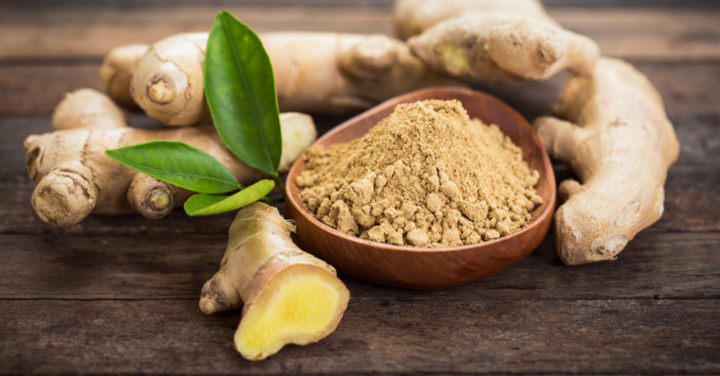Ginger
With its peppery, slightly sweet flavour and strong, spicy aroma, ginger has been used in traditional medicine for thousands of years. Extensive research shows that ginger can indeed help reduce period pain via its prostaglandin reducing anti-inflammatory properties.
Ginger can be consumed used in numerous forms; fresh, dried, pickled, preserved, crystallised, candied, and powdered or ground. However, the most widely studied way of taking ginger for period pain relief is via dried ginger root in capsule form. Dosage varies across studies from 750mg to 2000mg per day however there doesn’t seem to be a noticeable difference in the effect of larger doses, so it’s always a good idea to start with the lowest dose and only increase it slowly if you are not finding any benefit. Also, you don’t need to take a ginger supplement every day to get the benefits for your period pain, most studies recommend taking it two days before your period starts, and then for the first three days you are bleeding. Like all supplements, different brands of dried ginger root capsules can vary in size and strength, so be sure to check the label!
Whilst there is currently no clinical research on if including ginger in your cooking makes the same kind of improvements, if you enjoy the taste of ginger, it’s probably worth trying to include more in your diet. A thumb sized piece of ginger in your cooking three to four times per week might reduce your pain. If you don’t want to eat ginger for the whole month of your menstrual cycle, then start eating it the week before your period; that should be enough to notice the difference.

If you’d like to try ginger root but aren’t sure how to include it in your diet then you might like to try a simple ginger tea. A basic recipe follows and you can start drinking a cup or two per day a couple of days prior to your period and through the first few days of your period to see if it helps you:
- One piece of ginger root – about 2-3cm long (You can peel this if you want but you don’t have too).
- Grate or finely chop the ginger root.
- Bring 2 ½ cups of water to the boil.
- Add the ginger root, reduce heat to low and simmer, covered, for 10 minutes.
- Strain and drink 1 cup at a time, warm, once to twice per day.
(optional) add some sweetener if desired – usually about a teaspoon of honey, sugar, maple syrup or sweetener of your choice should do. It’s not essential but can take some of the ‘bite’ out of the tea and make it easier to drink.
Recommended dosage for relieving period pain:
Dried ginger root capsules equivalent to 750mg to 2000mg per day, starting two days before your period and continuing for the first three days of your cycle. There are currently no clinical guidelines for the dosage of ginger added to your diet in other forms however it is recommended to keep consumption under 5000mgs per day.
Safety issues:
Ginger is generally very safe to consume when taken at the recommended dosage. It can cause some mild side effects such as heartburn, and an upset tummy. However, like all supplements, you should talk to your healthcare provider or pharmacist if you are taking other medications or have other health conditions. There is some evidence that ginger might slow blood clotting. Taking ginger along with medications that also slow blood clotting might increase the risk of bruising and bleeding.
